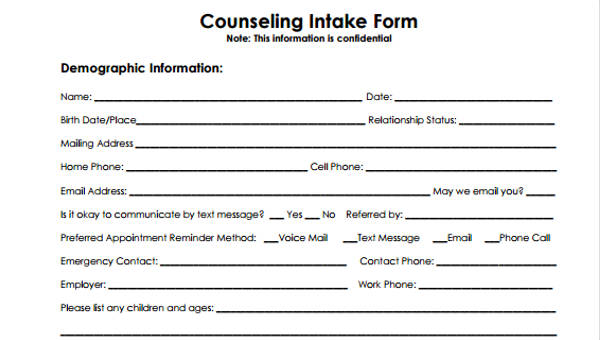Attorneys, lawyers and paralegals meet with potential clients to evaluate whether specific legal services meet client needs. During this intake process, many attorneys ask interview questions that give them more insight into a potential clients case. If youre streamlining your client intake process, consider conducting client interviews to help you learn more about potential cases. In this article, we discuss what client intake interview questions are, why theyre essential during the intake process and what questions you can ask to better assess new cases.
Intake and Assessment Role-Play Part 1 – Referral and Presenting Problems
What are client intake interview questions?
Client intake interview questions are part of a screening process lawyers, attorneys and paralegals use to evaluate potential clients. Private attorneys, corporate attorneys and attorneys working in law firms often use intake questions to learn more about a clients case, goals and desired outcomes. Typically, lawyers ask intake questions to gather additional information, documentation and witness accounts that help them determine the feasibility of achieving a clients desired outcome.
Using the client interview before accepting new cases is essential because it allows you to better understand how you can help potential clients and whether your law services are suitable for their specific needs. Consider several more benefits of using intake interview questions to evaluate potential cases:
Ensuring clients feel their concerns and needs are important helps attorneys build trust and establish relationships with clients. Asking questions and providing guidance encourages clients to feel comfortable seeking legal assistance with your firm. Intake interviews are also beneficial for showing clients that your firm approaches cases in a client-focused way, which is important to evaluate both the clients fit and your firms ability to help them.
14 Questions To Ask Your Clients
There are tons of questions you can ask your client during the intake session, and determining which questions are the “right questions” will depend on what your client is struggling with.
However, some questions help virtually any intake session, no matter what problem or issue your client is presenting with.
Dr. Dennis O’Grady identified 10 questions that are commonly asked in first sessions:
Building on the basics, therapist Maelisa Hall likes these four questions for an intake session:
Use these 14 questions as the basis of your intake session questions, and you’ll have a great foundation from which to work with your clients.
How To Conduct The Perfect Intake 101
First, it’s important to remember that the perfect intake session starts way before meeting with your client.
Before you sit down with your client or turn on your webcam for the intake meeting, make sure you:
Once you get face to face with your client (or webcam to webcam), the most important skill you can practice is good listening. You want to show compassion and empathy to build an effective therapeutic relationship with your client.
According to the professionals at Good Therapy, you can show empathy and compassion by:
Nondirective listening is being an active, good listener for your client without offering interpretation, explanation, or direction on where to go next.
Here are some ways you can practice nondirective listening:
However, there may be times when you need to practice directive listening. Directive listening is still active, nonjudgmental listening, but it adds other elements to guide the client towards insight and action.
Here are some ways to practice directive listening:
The balance in the types of listening you use will depend on your client, what they’re dealing with, and how you plan to move forward with them.
Aside from practicing good listening—which is vital in any session—therapy pros John and Rita Sommers-Flanagan identified three components of a successful intake session:
As you work through the initial session with your client, these three components should be at the forefront of your mind.
You don’t necessarily need to have a plan for exactly how therapy will progress after the first session, but you should understand (1) what the major issue is for your client, (2) who your client is, and the most relevant points in their background, and (3) how they’re doing right now.
If you’re interested in seeing an example of an intake and assessment in action, there are several good videos on this topic.
The video below from Dr. Todd Grande is one of the most popular videos showing how an intake session should go.
This role-play showcases the most vital parts of the client intake: he communicates nonjudgmentally, he asks pertinent questions to gather information about the client, he asks for clarifications when needed, and he uses good listening skills in general.
Notice how Dr. Grande uses both nondirective listening (e.g., making eye contact, facing the client, using a friendly tone) and directive listening (e.g., feeling validation, interpretation) skills to build a rapport with his client.
If you want to see more, the role-play continues in further videos from Dr. Grande.
According to counselor Adam Bagley, several things should make it onto any intake form, including:
Here’s a great template for an Adult Psychotherapy Intake Form that checks most of the boxes above.
Quenza’s Coaching Client Agreement, pictured below, is also freely available as a customizable template for platform members:
Along with the platform’s Pre-Coaching Questionnaire, Session Rating Scale, and more, this can quickly be personalized using pre-populated fields such as Client Name and Professional Name – all are available with Quenza’s $1 monthly trial.
It’s also important to have your client fill out an acknowledgment of informed consent. You can bundle this with your intake form, but here’s an Informed Consent Form for Assessment and Treatment from the pros at ICANotes if you decide to keep it separate.
You might also want a Records Release Authorization form that allows you to release or receive mental information about them from another care provider.
This is another helpful Records Release Authorization template from ICANotes.

